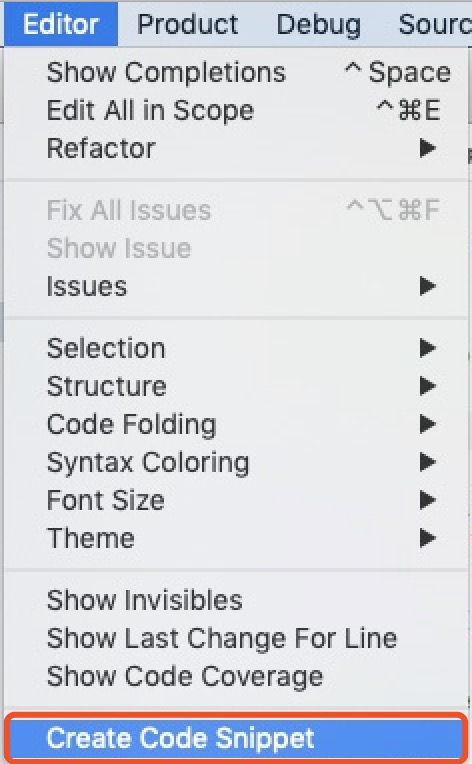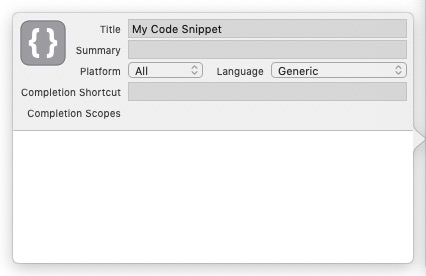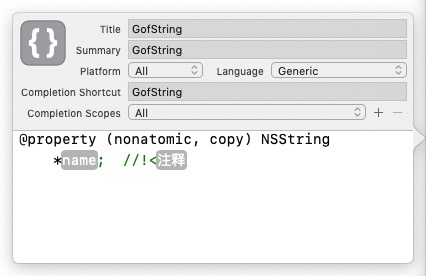XCode中的Code Snippet
Xcode4 引入了一个新 feature: Code Snippets,它是一些代码的模版,对于一些常见的编程模式,Xcode 都将这些代码抽象成模版放到 Code Snippets 中,使用的时候,只需要键入快捷键,就可以把模版的内容填到代码中。
1.怎样定义代码块?
选择 "Editor" --> "Create Code Snippet",如下图所示:

点击之后,打开如下的编辑页面:

- Title:Code Snippet的名称;
- Summary:摘要;
- Platform:平台;
- Language:适用语言;
- Completion Shortcut:快捷键(建议选一个自己常用的前缀来命名);
- Completion Scopes:自定义的常用代码块。
示例如下:

之前定义方式:选中整块代码,拖动到 xcode 右下角的 code snippets 区域中即可。xcode 会自动帮你创建一个新的代码片段。之后你可以单击该代码片段,在弹出的界面中选择 edit,即可为此代码片段设置快捷键等信息。
2.常用代码块
2.1Assign属性
@property (nonatomic, assign) <#type#> <#name#>; //!<<#注释#>
2.2字符串属性
@property (nonatomic, copy) NSString *<#name#>; //!<<#注释#>
2.3Strong属性
@property (nonatomic, strong) <#type#> *<#name#>; //!<<#注释#>
2.4Weak修饰
__weak typeof(self)weakSelf = self;
2.5Strong修饰
__strong __typeof(<#weakSelf#>)strongSelf = <#weakSelf#>;
2.6UITableViewDataSource
#pragma mark - UITableViewDataSource - (NSInteger)numberOfSectionsInTableView:(UITableView *)tableView { return <#Section Number#>; } - (NSInteger)tableView:(UITableView *)tableView numberOfRowsInSection:(NSInteger)section { return <#Rows Number#>; } - (UITableViewCell *)tableView:(UITableView *)tableView cellForRowAtIndexPath:(NSIndexPath *)indexPath { UITableViewCell *cell = [tableView dequeueReusableCellWithIdentifier:<#reuseIdentifier#> forIndexPath:<#indexPath#>]; <#statements#> return cell; }
2.7UITableViewDelegate
#pragma mark - UITableViewDelegate - (void)tableView:(UITableView *)tableView didSelectRowAtIndexPath:(NSIndexPath *)indexPath { <#statements#> }
2.8生成单例方法
+ (instancetype)shared<#name#> { static <#class#> *_shared<#name#> = nil; static dispatch_once_t onceToken; dispatch_once(&onceToken, ^{ _shared<#name#> = <#initializer#>; }); return _shared<#name#>; }
2.9定义Pragma
#pragma mark - <#Section#>
2.10类扩展
@interface <#Class Name#> () <#Continuation#> @end
2.11GCD主线程队列
dispatch_async(dispatch_get_main_queue(), ^{ <#code#> });
2.12GCD全局队列
dispatch_async(dispatch_get_global_queue(DISPATCH_QUEUE_PRIORITY_DEFAULT, 0), ^(void) { <#code#> });
2.13Window初始化
self.window = [[UIWindow alloc] initWithFrame:[[UIScreen mainScreen] bounds]]; ViewController *vc = [[ViewController alloc] init]; UINavigationController *nav = [[UINavigationController alloc] initWithRootViewController:vc]; self.window.rootViewController = nav; self.window.backgroundColor = [UIColor whiteColor]; [self.window makeKeyAndVisible];
2.14Get方法
- (<#TYPE#> *)<#NAME#> { if (nil == _<#NAME#>) { _<#NAME#> = [[<#TYPE#> alloc] init]; } return _<#NAME#>; }
2.15Enum枚举
typedef NS_ENUM(NSUInteger, <#Name#>) { <#value0#> = 0, <#value1#> };
2.16OPTIONS枚举
typedef NS_OPTIONS(NSInteger, <#name#>) { <#value0#> = 0, <#value1#> = 1 };
无善无恶心之体,
有善有恶意之动,
知善知恶是良知,
为善去恶是格物。




 浙公网安备 33010602011771号
浙公网安备 33010602011771号